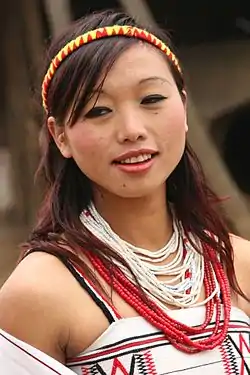Khelma people
The Khelma, also known as the Sakachep are one of the old Kuki tribes of northeastern parts of India.
.jpg.webp)
| Total population | |
|---|---|
| Approx. 5000 | |
| Regions with significant populations | |
| Languages | |
| Sakachep, Achep | |
| Religion | |
| Predominantly Presbyterianism | |
| Related ethnic groups | |
| Mizo · Hmar · Chin · Kuki |
The Sakachep tribe is one of the small tribes in the Old Kuki community. The live in the several areas of Assam, including Dima Hasao, Karbi Anglong and Jaintia Hills. They also can be found in Nagaland, in Peren, and in Mizoram and Tripura.
Culture
Their life style and habits closely resemble the other tribes of the Chin-Kuki people. Among the inhabitants of the Dima Hasao district, the Sakachep are one of the smallest communities. The Sakachep are similar in language, customs and traditions to the Biate and Hrangkhol. They used to cremate their dead like the Vedic Hindu in the past.[1] However, 80% of the population are Christians today. They are entirely dependent on agriculture for their livelihood.
The Sakachep also celebrate different festivals which are connected with the worshiping of different gods and goddess during the year. Saakthar, Rubu-khat, Parsem-kut, Inmuthung and Rubuthum are such festivals. Rubuthum is the most important of all the ceremonies of the Khelmas during the time when they used to worship nature. It is believed that one has to perform the ceremony to bring peace in the family. Parsem Kut is one of the biggest festival, celebrated in the month of April. The Khelmas have a good number of folk songs for different occasions, which are generally slow tuned.
The Sakachep are known for their distinct style of dress. The women wear strings of different beads and coins around their neck. Today, the majority of the young boys and girls of the villages wear pants, shirts and traditional Mekhela. The older men simply wear a Dhoti|dhuti.
The traditional social administration of the Sakachep is known as the Halam, which is headed by a Kalim and Kabur. In the Khelma community, a young man has to serve his father-in-law for four years before he is allowed to take his wife home. This system is called the Maksa.
References
- Soppitt, C. A. (1893). A Short Account of the Kuki–Lushai Tribes of the North-East Frontier (Districts Cachar, Sylhet, Naga Hills, etc., and Dima Hasao) With An Outline Grammar of the Rangkhol-Lushai Language and a Comparison of Lushai With Other Dialects. (Reprint, 1976). Culcutta: Firma-KLM Pvt. Ltd.
